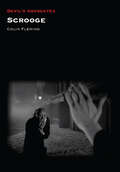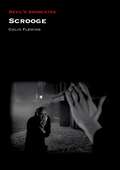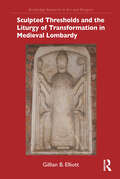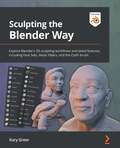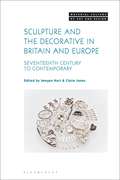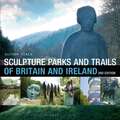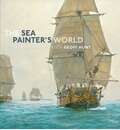- Table View
- List View
Scriptwriting for Web Series: Writing for the Digital Age
by Marie Drennan Yuri Baranovsky Vlad BaranovskyScriptwriting for Web Series: Writing for the Digital Age offers aspiring writers a comprehensive how-to guide to scriptwriting for web series in the digital age. Containing in-depth advice on writing both short- and long-form webisodes as part of a series, as well as standalone pieces, it goes beyond the screenwriting process to discuss production, promotion and copyright in order to offer a well-rounded guide to creating and distributing a successful web series. Written in a friendly, readable and jargon-free style by an experienced scriptwriting professor and two award-winning web series creators, it offers invaluable professional insights, as well as examples from successful series, sample scripts and interviews with key series creators, writers and industry professionals.
Scrooge (Devil's Advocates)
by Colin FlemingThis Devil’s Advocate explores the cinematic wonders of Brian Desmond Hurst’s much loved 1951 adaptation of A Christmas Carol, Scrooge, through the prism of horror cinema, arguing that the film has less in common with cosy festive tradition than it does with terror cinema like James Whale’s Bride of Frankenstein, Robert Weine’s The Cabinet of Dr. Caligari, and F.W. Murnau’s Faust. Beginning with Charles Dickens himself, a prolific writer of ghost stories, with A Christmas Carol being but one of many, Colin Fleming then considers earlier cinematic adaptations including 1935’s folk-horror-like Scrooge, before offering a full account of the Hurst/Sim version, stressing what must always be kept at the forefront of our minds: this is a ghost story.
Scrooge (Devil's Advocates)
by Colin FlemingThis Devil’s Advocate explores the cinematic wonders of Brian Desmond Hurst’s much loved 1951 adaptation of A Christmas Carol, Scrooge, through the prism of horror cinema, arguing that the film has less in common with cosy festive tradition than it does with terror cinema like James Whale’s Bride of Frankenstein, Robert Weine’s The Cabinet of Dr. Caligari, and F.W. Murnau’s Faust. Beginning with Charles Dickens himself, a prolific writer of ghost stories, with A Christmas Carol being but one of many, Colin Fleming then considers earlier cinematic adaptations including 1935’s folk-horror-like Scrooge, before offering a full account of the Hurst/Sim version, stressing what must always be kept at the forefront of our minds: this is a ghost story.
Sculpted Thresholds and the Liturgy of Transformation in Medieval Lombardy (Routledge Research in Art and Religion)
by Gillian B. ElliottThis book explores the issue of ecclesiastical authority in Romanesque sculpture on the portals and other sculpted “gateways” of churches in the north Italian region of Lombardy. Gillian B. Elliott examines the liturgical connection between the ciborium over the altar (the most sacred threshold inside the church), and the sculpted portals that appeared on church exteriors in medieval Lombardy. In cities such as Milan, Civate, Como, and Pavia, the liturgy of Saint Ambrose was practiced as an alternative to the Roman liturgy and the churches were constructed to respond to the needs of Ambrosian liturgy. Not only do the Romanesque churches in these places correspond stylistically and iconographically, but they were also linked politically in an era of intense struggle for ultimate regional authority. The book considers liturgical and artistic links between interior church furnishings and exterior church sculptural programs, and also applies new spatial methodologies to the interior and exterior of churches in Lombardy. The book will be of interest to scholars working in art history, medieval studies, architectural history, and religious studies.
Sculpted Thresholds and the Liturgy of Transformation in Medieval Lombardy (Routledge Research in Art and Religion)
by Gillian B. ElliottThis book explores the issue of ecclesiastical authority in Romanesque sculpture on the portals and other sculpted “gateways” of churches in the north Italian region of Lombardy. Gillian B. Elliott examines the liturgical connection between the ciborium over the altar (the most sacred threshold inside the church), and the sculpted portals that appeared on church exteriors in medieval Lombardy. In cities such as Milan, Civate, Como, and Pavia, the liturgy of Saint Ambrose was practiced as an alternative to the Roman liturgy and the churches were constructed to respond to the needs of Ambrosian liturgy. Not only do the Romanesque churches in these places correspond stylistically and iconographically, but they were also linked politically in an era of intense struggle for ultimate regional authority. The book considers liturgical and artistic links between interior church furnishings and exterior church sculptural programs, and also applies new spatial methodologies to the interior and exterior of churches in Lombardy. The book will be of interest to scholars working in art history, medieval studies, architectural history, and religious studies.
Sculpting The Blender Way: Explore Blenders 3d Sculpting Workflows And Latest Features Such As Face Sets, Mesh Filters, And The Cloth Brush
by Xury GreerExplore Blender's 3D sculpting workflows and latest features, including Face Sets, Mesh Filters, and the Cloth brush
Sculpting in ZBrush Made Simple: Explore powerful modeling and character creation techniques used for VFX, games, and 3D printing
by Lukas KutscheraJumpstart your sculpting career by learning the industry's most effective modeling and sculpting tools used by professionals to create AAA-quality characters, props, and lifelike portraitsKey FeaturesMaster the basics of ZBrush through practical projects in this illustrated guideExplore organic modeling, concept sculpting, and character creation workflowsDiscover tools and techniques employed by professionals from the games, VFX and collectibles industriesPurchase of the print or Kindle book includes a free PDF eBookBook DescriptionEmbark on a creative journey with ZBrush, the leading software for creating characters, creatures, and props in films, games, and 3D printing. This guide will take you through its powerful yet user-friendly workflows, allowing you to explore its dynamic organic sculpting, painting, and hard-surface modeling tools. The first part of this book is dedicated to helping you become familiar with ZBrush’s user interface and learning the very basics, from sculpting brushes and painting the model with Polypaint to setting up lights and rendering images. You’ll also create a demon bust with the help of ZBrush’s concept sculpting tool, DynaMesh. In the second part, you’ll get to grips with the creation of a humanoid character that is optimized for 3D printing. Focusing on anatomy, poly-modeling, and preparing the model for 3D printing, you’ll acquire the skills essential for sculptors. The final part delves into portrait sculpting, where you’ll learn everything from basic facial anatomy to hair creation with FiberMesh. By the end of this book, you'll have developed the expertise necessary to succeed in the ever-evolving world of 3D character modeling, complemented by portfolio and social media tips for showcasing your standout work.What you will learnEnhance your sculpting skills to craft a variety of organic and hard surface objectsCreate humanoid characters, focusing on basic anatomy and proportionsExplore sculpting techniques for intricate details in human heads and hairSculpt objects such as armor, clothing, and accessoriesCreate custom brushes to enhance your sculpting workflowDevelop skills in detailing and surfacing to add texture and depth to your sculptsUse Polypaint and Materials to add color and enhance your sculpturesRender and export your sculpts to share them with othersWho this book is forThis book is for 3D artists, digital sculptors, modelers, and anyone looking to learn the ZBrush software. It's a valuable resource for professionals switching to ZBrush or looking to broaden their skill set. While prior ZBrush experience and artistic abilities will prove beneficial, they're not prerequisites to understand the content covered. The book covers common and essential ZBrush workflows, making it ideal for both beginner and intermediate artists looking to explore the extensive capabilities of ZBrush.
A Sculptor's Manual: The Commonwealth and International Library: Painting, Sculpture and Fine Arts
by Bainbridge CopnallA Sculptor's Manual focuses on the methods involved in sculpture. The manual first outlines drawing as a medium by which artistic creativity can evolve. The text notes that mastery of this talent can enable artists to become more analytical in their appreciation of their fellow beings, as well as bring out the inventive faculties in them in many ways. The book also discusses direct carving and the use of cartoons and automatic tools in carving. The work done by the author at the Henry Florence Memorial Hall is noted. The varieties of stones that can be used as medium in carving are explained. The text also looks at the methods in moving heavy weights, traditional carving of relief, and wood carving. Modeling as a way to create fine pieces of sculpture is underscored. The book also discusses the methods involved in building a large bronze memorial and an enormous aluminum stag. Alternative methods of casting a large memorial are also elaborated. The text also puts emphasis on fiberglass sculpture, including materials and methods to be employed. The manual is a good reference for beginner and master sculptors.
Sculpture: Some Observations on Shape and Form from Pygmalion's Creative Dream (Studies In Communication, Media, And Public Opinion)
by Johann Gottfried Herder"The eye that gathers impressions is no longer the eye that sees a depiction on a surface; it becomes a hand, the ray of light becomes a finger, and the imagination becomes a form of immediate touching."—Johann Gottfried Herder Long recognized as one of the most important eighteenth-century works on aesthetics and the visual arts, Johann Gottfried Herder's Plastik (Sculpture, 1778) has never before appeared in a complete English translation. In this landmark essay, Herder combines rationalist and empiricist thought with a wide range of sources—from the classics to Norse legend, Shakespeare to the Bible—to illuminate the ways we experience sculpture. Standing on the fault line between classicism and romanticism, Herder draws most of his examples from classical sculpture, while nevertheless insisting on the historicity of art and of the senses themselves. Through a detailed analysis of the differences between painting and sculpture, he develops a powerful critique of the dominance of vision both in the appreciation of art and in our everyday apprehension of the world around us. One of the key articulations of the aesthetics of Sturm und Drang, Sculpture is also important as an anticipation of subsequent developments in art theory. Jason Gaiger's translation of Sculpture includes an extensive introduction to Herder's thought, explanatory notes, and illustrations of all the sculptures discussed in the text.
Sculpture: Some Observations on Shape and Form from Pygmalion's Creative Dream (Studies In Communication, Media, And Public Opinion)
by Johann Gottfried Herder"The eye that gathers impressions is no longer the eye that sees a depiction on a surface; it becomes a hand, the ray of light becomes a finger, and the imagination becomes a form of immediate touching."—Johann Gottfried Herder Long recognized as one of the most important eighteenth-century works on aesthetics and the visual arts, Johann Gottfried Herder's Plastik (Sculpture, 1778) has never before appeared in a complete English translation. In this landmark essay, Herder combines rationalist and empiricist thought with a wide range of sources—from the classics to Norse legend, Shakespeare to the Bible—to illuminate the ways we experience sculpture. Standing on the fault line between classicism and romanticism, Herder draws most of his examples from classical sculpture, while nevertheless insisting on the historicity of art and of the senses themselves. Through a detailed analysis of the differences between painting and sculpture, he develops a powerful critique of the dominance of vision both in the appreciation of art and in our everyday apprehension of the world around us. One of the key articulations of the aesthetics of Sturm und Drang, Sculpture is also important as an anticipation of subsequent developments in art theory. Jason Gaiger's translation of Sculpture includes an extensive introduction to Herder's thought, explanatory notes, and illustrations of all the sculptures discussed in the text.
Sculpture: Some Observations on Shape and Form from Pygmalion's Creative Dream
by Johann Gottfried Herder"The eye that gathers impressions is no longer the eye that sees a depiction on a surface; it becomes a hand, the ray of light becomes a finger, and the imagination becomes a form of immediate touching."—Johann Gottfried Herder Long recognized as one of the most important eighteenth-century works on aesthetics and the visual arts, Johann Gottfried Herder's Plastik (Sculpture, 1778) has never before appeared in a complete English translation. In this landmark essay, Herder combines rationalist and empiricist thought with a wide range of sources—from the classics to Norse legend, Shakespeare to the Bible—to illuminate the ways we experience sculpture. Standing on the fault line between classicism and romanticism, Herder draws most of his examples from classical sculpture, while nevertheless insisting on the historicity of art and of the senses themselves. Through a detailed analysis of the differences between painting and sculpture, he develops a powerful critique of the dominance of vision both in the appreciation of art and in our everyday apprehension of the world around us. One of the key articulations of the aesthetics of Sturm und Drang, Sculpture is also important as an anticipation of subsequent developments in art theory. Jason Gaiger's translation of Sculpture includes an extensive introduction to Herder's thought, explanatory notes, and illustrations of all the sculptures discussed in the text.
Sculpture and the Decorative in Britain and Europe: Seventeenth Century to Contemporary (Material Culture of Art and Design)
by Imogen Hart and Claire JonesBy foregrounding the overlaps between sculpture and the decorative, this volume of essays offers a model for a more integrated form of art history writing. Through distinct case studies, from a seventeenth-century Danish altarpiece to contemporary British ceramics, it brings to centre stage makers, objects, concepts and spaces that have been marginalized by the enforcement of boundaries within art and design discourse. These essays challenge the classed, raced and gendered categories that have structured the histories and languages of art and its making. Sculpture and the Decorative in Britain and Europe is essential reading for anyone interested in the history and practice of sculpture and the decorative arts and the methodologies of art history.
Sculpture and the Decorative in Britain and Europe: Seventeenth Century to Contemporary (Material Culture of Art and Design)
By foregrounding the overlaps between sculpture and the decorative, this volume of essays offers a model for a more integrated form of art history writing. Through distinct case studies, from a seventeenth-century Danish altarpiece to contemporary British ceramics, it brings to centre stage makers, objects, concepts and spaces that have been marginalized by the enforcement of boundaries within art and design discourse. These essays challenge the classed, raced and gendered categories that have structured the histories and languages of art and its making. Sculpture and the Decorative in Britain and Europe is essential reading for anyone interested in the history and practice of sculpture and the decorative arts and the methodologies of art history.
Sculpture Collections in Early Modern Spain
by Kelley Helmstutler Dio Rosario CoppelIn the past decade, there has been a surge of Anglophone scholarship regarding Spain in the sixteenth and seventeenth centuries, which has led to a reframing of the discourses around Spanish culture of this period. Despite this new interest-in which painting, in particular, has been singled out for treatment-a comprehensive study of sculpture collections and the status of sculpture in Spain has yet to be produced. Sculpture Collections in Early Modern Spain is the first book to assess the phenomenon of sculpture collecting and in doing so, it alters the previously held notion that Spanish society placed little value in this art form. Di Dio and Coppel reveal that, due to the problems and expense of their transport from Italy, sculptures were in fact status symbols in the culture. Thus they were an important component of the collections formed by the royal family, cultivated noble collectors, humanists, and artists who had pretensions of high status. This book is especially useful to specialists for its discussion of the typologies of collections and objects, and of the mechanics of state gifts, transport, and collection display in this period. An appendix presents extensive archival documentation, most of which has never before been published. The authors have uncovered hundreds of new documents about sculpture in Spain; and new documentary evidence allows them to propose several new identifications and attributions. Firmly grounded in extensive archival research, Sculpture Collections in Early Modern Spain redefines the socio-political and art historical importance of sculpture in early modern Spain. Most importantly, it entirely transforms our knowledge regarding the presence of sculpture in a wide range of Spanish collections of the period, which until now has been erroneously characterized as close to non-existent.
Sculpture Collections in Early Modern Spain
by Kelley Helmstutler Dio Rosario CoppelIn the past decade, there has been a surge of Anglophone scholarship regarding Spain in the sixteenth and seventeenth centuries, which has led to a reframing of the discourses around Spanish culture of this period. Despite this new interest-in which painting, in particular, has been singled out for treatment-a comprehensive study of sculpture collections and the status of sculpture in Spain has yet to be produced. Sculpture Collections in Early Modern Spain is the first book to assess the phenomenon of sculpture collecting and in doing so, it alters the previously held notion that Spanish society placed little value in this art form. Di Dio and Coppel reveal that, due to the problems and expense of their transport from Italy, sculptures were in fact status symbols in the culture. Thus they were an important component of the collections formed by the royal family, cultivated noble collectors, humanists, and artists who had pretensions of high status. This book is especially useful to specialists for its discussion of the typologies of collections and objects, and of the mechanics of state gifts, transport, and collection display in this period. An appendix presents extensive archival documentation, most of which has never before been published. The authors have uncovered hundreds of new documents about sculpture in Spain; and new documentary evidence allows them to propose several new identifications and attributions. Firmly grounded in extensive archival research, Sculpture Collections in Early Modern Spain redefines the socio-political and art historical importance of sculpture in early modern Spain. Most importantly, it entirely transforms our knowledge regarding the presence of sculpture in a wide range of Spanish collections of the period, which until now has been erroneously characterized as close to non-existent.
Sculpture Parks and Trails of Britain & Ireland
by Alison StaceThe ultimate illustrated guide to the sculpture parks and trails of England, Scotland, Ireland and Wales.This exciting guide to the sculpture parks, trails and gardens of England, Ireland, Scotland and Wales is the perfect book for those who like art and the outdoors. Divided up into countries and regions, the book is informative as well as beautifully illustrated with fabulous images of sculptures by a broad array of international artists. It provides information on all the major sculpture venues of interest, featuring the best and most established, while also providing a wide range of other interesting places to visit and explore. Each feature provides directions of how to get there, along with an overview of the park or trail, and lists sculptures of particular interest and quality, while maps of each area will help you find places close by to visit. This makes it easy to see which places are suited to you depending on your preferences, level of interest and time available. This fully revised 2nd edition provides updated information and new entries for England, as well as brand new sections providing thorough coverage of Scotland, Ireland and Wales. The ideal guide for those with a passion for both nature and sculptures.
Sculpture, Sexuality and History: Encounters in Literature, Culture and the Arts from the Eighteenth Century to the Present (Genders and Sexualities in History)
by Jana Funke Jen GroveThis book investigates the wide-ranging connections between sculpture, sexuality, and history in Western culture from the eighteenth century to the present. Sculpture has offered a privileged site for the articulation of sexual experience and the formation of sexual knowledge. As historical objects, sculptures also draw attention to the different ways in which knowledge about sexuality is facilitated through an engagement with the past. Bringing together contributors from across disciplines, including art history, classics, film studies, gender studies, history, literary studies, museum studies, queer theory and reception studies, the volume presents original readings of sculptural art in relation to antiquarianism, aesthetics, collecting cultures, censorship and obscenity, psychoanalysis, sexology, and the experience and regulation of museum spaces. It examines how sculptural encounters were imagined and articulated in literature, painting, film and science. As a whole, the book opens up a new understanding of the ways in which sculptures, as real or imagined objects, have fundamentally shaped approaches to and receptions of the past in relation to sex, gender and sexuality.Chapters 8 and 10 of this book are available open access under a CC BY 4.0 license at link.springer.com.
Sculpture Workshops as Space and Concept: Creating the Portrait (Routledge Research in Art History)
by Jane FejferThis book explores the multifaceted aspects of sculptor’s workshops from the Renaissance to the early nineteenth century. Contributors take a fresh look at the sculptor’s workshop as both a physical and discursive space. By studying some of the most prominent artists’ sculptural practices, the workshop appears as a multifaced, sociable and practical space. The book creates a narrative in which the sculptural workshop appears as a working laboratory where new measuring techniques, new materials and new instruments were tested and became part of the lived experience of the artist and central to the works coming into being. Artists covered include Donatello, Roubilliac, Thorvaldsen, Canova, and Christian Daniel Rauch. The book will be of interest to scholars studying art history, sculpture, artist workshops, and European studies.
Sculpture Workshops as Space and Concept: Creating the Portrait (Routledge Research in Art History)
by Jane Fejfer Kristine Bøggild JohannsenThis book explores the multifaceted aspects of sculptor’s workshops from the Renaissance to the early nineteenth century. Contributors take a fresh look at the sculptor’s workshop as both a physical and discursive space. By studying some of the most prominent artists’ sculptural practices, the workshop appears as a multifaced, sociable and practical space. The book creates a narrative in which the sculptural workshop appears as a working laboratory where new measuring techniques, new materials and new instruments were tested and became part of the lived experience of the artist and central to the works coming into being. Artists covered include Donatello, Roubilliac, Thorvaldsen, Canova, and Christian Daniel Rauch. The book will be of interest to scholars studying art history, sculpture, artist workshops, and European studies.
SDGs in Construction Economics and Organization: The 11th Nordic Conference on Construction Economics and Organisation (CREON), May 18-20, 2022 (Springer Proceedings in Business and Economics)
by Göran Lindahl Stefan Christoffer GottliebThis book examines how research in construction economics and organization contributes to the achievement of the SDGs. Featuring selected contributions from the 11th Nordic Conference on Construction Economics and Organisation (CREON 2022) held in Copenhagen, Demark and Malmö, Sweden, the contributions of this book explore the ways in which research in construction economics and organization assists in building resilient infrastructure, fostering green innovations and contributes to sustainable economic growth. Each contribution relates to one or more individual SDG and describes how the research contributes to the understanding of construction management and economics.
Sea Currents in Nineteenth-Century Art, Science and Culture: Commodifying the Ocean World (Biotechne: Interthinking Art, Science and Design)
by Kathleen Davidson and Molly DugginsHow did scientists, artists, designers, manufacturers and amateur enthusiasts experience and value the sea and its products? Examining the commoditization of the ocean world during the nineteenth century, this book demonstrates how the transaction of oceanic objects inspired a multifaceted material discourse stemming from scientific exploration, colonial expansion, industrialization, and the rise of middle-class leisure. From the seashore to the seabed, marine organisms and environments, made tangible through processing and representational technologies, captivated practitioners and audiences. Combining essays and case studies by scholars, curators, and scientists, Sea Currents investigates the collecting and display, illustration and ornamentation, and trade and consumption of marine flora and fauna, analysing their material, aesthetic and commercial dimensions. Traversing global art history, the history of science, empire studies, anthropology, ecocriticism and material culture, this book surveys the currency of marine matter embedded in the economies and ecologies of a modernizing ocean world.
Sea Currents in Nineteenth-Century Art, Science and Culture: Commodifying the Ocean World (Biotechne: Interthinking Art, Science and Design)
How did scientists, artists, designers, manufacturers and amateur enthusiasts experience and value the sea and its products? Examining the commoditization of the ocean world during the nineteenth century, this book demonstrates how the transaction of oceanic objects inspired a multifaceted material discourse stemming from scientific exploration, colonial expansion, industrialization, and the rise of middle-class leisure. From the seashore to the seabed, marine organisms and environments, made tangible through processing and representational technologies, captivated practitioners and audiences. Combining essays and case studies by scholars, curators, and scientists, Sea Currents investigates the collecting and display, illustration and ornamentation, and trade and consumption of marine flora and fauna, analysing their material, aesthetic and commercial dimensions. Traversing global art history, the history of science, empire studies, anthropology, ecocriticism and material culture, this book surveys the currency of marine matter embedded in the economies and ecologies of a modernizing ocean world.
Sea Fret (Modern Plays)
by Tallulah BrownThe sea took my house and not yours, everything's different for me. Rising sea levels are threatening the ground beneath her house, but Ruby is distracted. She wants one final blowout before her best friend, Lucy, leaves for University.With the local community in favour of letting nature take its course, Ruby must choose: follow Lucy inland or stay and help her father hold back the tide.Sea Fret is about erosion - the collapse of friendship, family and home. Tallulah Brown's play is a paean to her native Suffolk coastline. It received its world premiere at the Old Red Lion Theatre, London, on 28 March 2017.
Sea Fret (Modern Plays)
by Tallulah BrownThe sea took my house and not yours, everything's different for me. Rising sea levels are threatening the ground beneath her house, but Ruby is distracted. She wants one final blowout before her best friend, Lucy, leaves for University.With the local community in favour of letting nature take its course, Ruby must choose: follow Lucy inland or stay and help her father hold back the tide.Sea Fret is about erosion - the collapse of friendship, family and home. Tallulah Brown's play is a paean to her native Suffolk coastline. It received its world premiere at the Old Red Lion Theatre, London, on 28 March 2017.
The Sea Painter's World: The new marine art of Geoff Hunt, 2003-2010
by Geoff HuntThis timely follow-up to Conway's highly successful Marine Art of Geoff Hunt (2004) presents the considerable artistic output of Britain's leading marine painter since 2003. This new volume is heavily illustrated with images ranging from large paintings to sketchbook drawings with text written by the artist himself. The new book reflects Hunt's developing career during a time in which he served a five-year term as President of the Royal Society of Marine Artists, worked on large-scale paintings such as the definitive Mary Rose,and also completed numerous outdoor sketches and paintings. The book is divided into six sections: 1. The Sea Painter's World, an introduction to the artist's studio work at Merton Place, London and his plein air work on the River Thames; 2. Home Waters; 3. The Mediterranean; 4. In the Wake of Nelson; 5. North America and 6. The West Indies and Beyond. This concept sets Geoff's work in a broadly geographical context, showcasing the artist's freer plein air style alongside the exhaustively researched maritime history paintings to which he owes his standing as Britain's leading marine artist.

